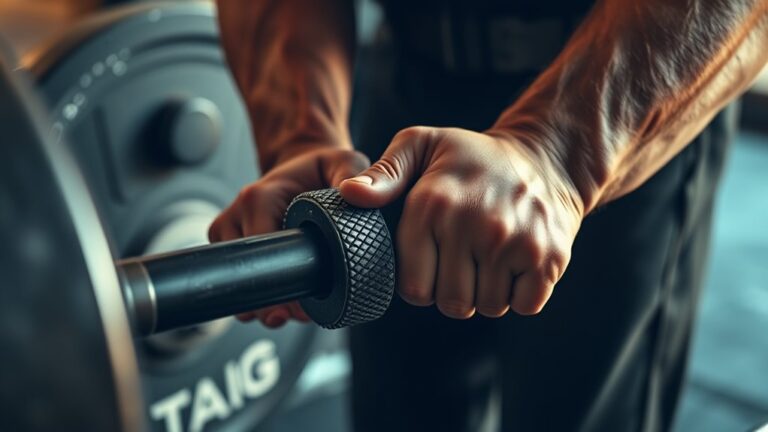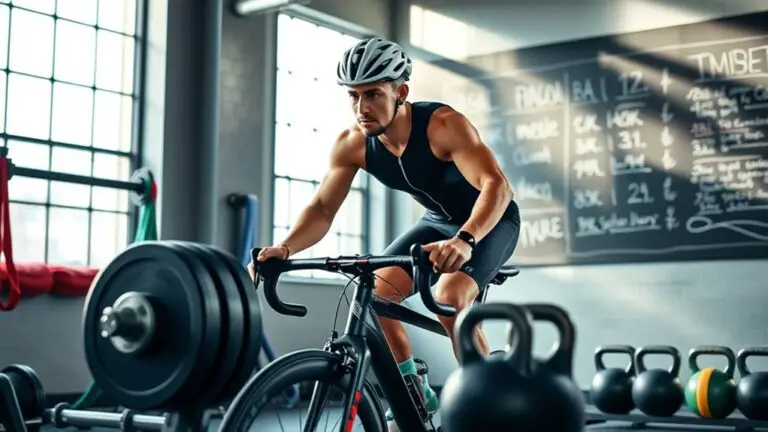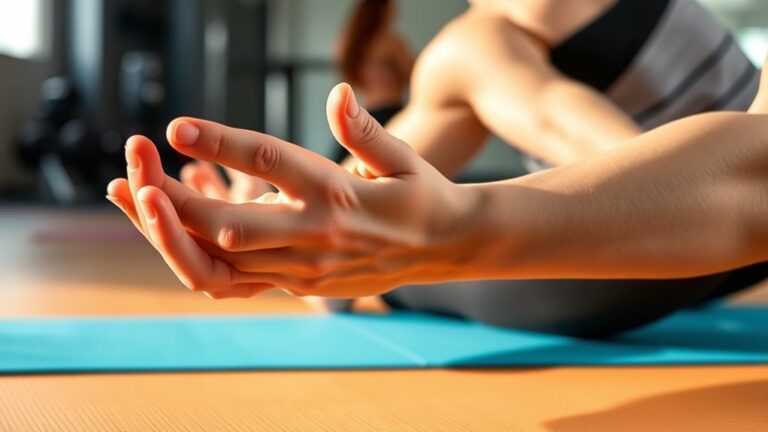How to Build Bigger Calves at the Gym
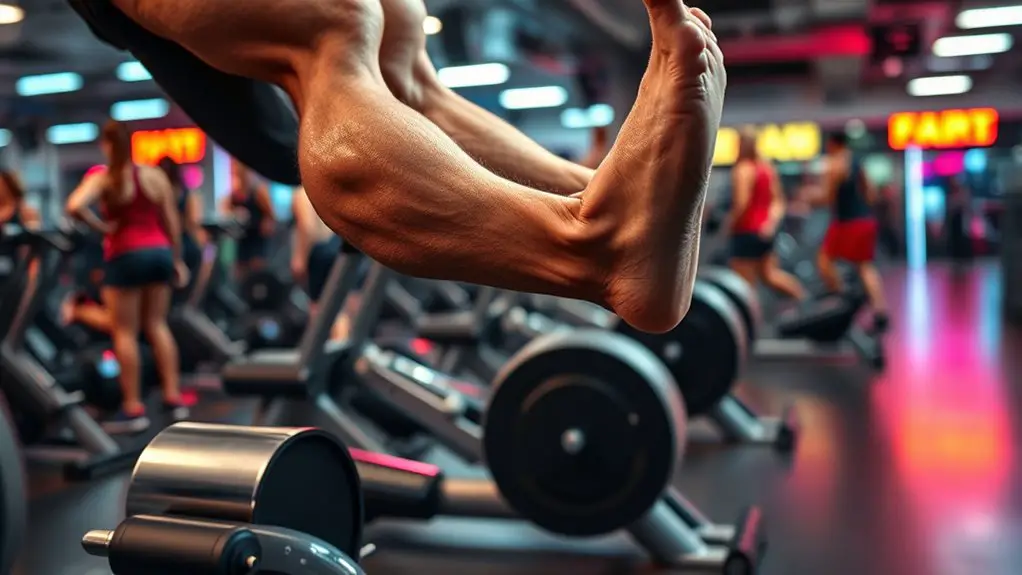
To build bigger calves at the gym, focus on targeted exercises like calf raises, both seated and standing, to engage the gastrocnemius and soleus muscles. Incorporate 2-3 workouts per week, aiming for 3 to 5 sets of 8-15 reps for growth. Remember to allow for adequate recovery and mix in varied exercises to prevent plateaus. Nutrition also plays a key role, so make sure you’re eating enough to support muscle repair. There’s more to uncover about effective techniques and adjustments.
Understanding Calf Anatomy

To effectively build bigger calves, you first need to understand their anatomy. The calf consists of two primary muscle types: the gastrocnemius and the soleus. The gastrocnemius, which has a prominent role in generating power, is activated during activities like running and jumping. It’s important to note that the soleus, located beneath the gastrocnemius, plays a vital role in maintaining posture and stabilizing your ankle during movement.
Focusing on both muscles is essential for balanced development. Ensuring proper ankle mobility will enhance your range of motion during exercises, leading to better training adaptations. When you incorporate exercises targeting both muscle types, you’ll promote overall calf growth and strength. Remember, safety should always come first—start with lighter weights and gradually increase as you build confidence and strength. Understanding these aspects will help you train effectively and safely for bigger calves.
Common Mistakes in Calf Training
Many people overlook key aspects of calf training, leading to stagnant progress and frustration. One common pitfall is not varying your exercises enough. Sticking to the same routines can limit muscle growth and strength, so it’s essential to mix things up. Another mistake is neglecting proper form. Exercise errors, like bouncing or using too much weight, can not only hinder your results but also increase the risk of injury. It’s also important to focus on both parts of the calf muscles: the gastrocnemius and the soleus, or العضلات السفلية. Many enthusiasts only target one, which can lead to imbalances. Additionally, don’t forget to allow for adequate recovery time; overtraining can be just as detrimental as undertraining. By incorporating exercises like jumping rope, you can effectively improve coordination and balance, further enhancing your calf training and achieving better, safer results.
Essential Calf Exercises

Building bigger calves requires a focus on essential exercises that effectively target both the gastrocnemius and soleus muscles. Incorporating a variety of calf exercises is key to achieving balanced growth and strength. Here are some great options:
| Exercise Type | Description | Equipment Needed |
|---|---|---|
| Calf Raises | Targets both calf muscles | None or barbell |
| Seated Calf | Focuses on the soleus | Seated calf machine |
| Standing Calf | Emphasizes the gastrocnemius | Standing calf machine |
| Donkey Calf | Engages both muscles effectively | Calf raise machine |
Don’t forget to include calf variations like plyometric calves for added explosiveness. Isolation exercises will help you to focus on form and prevent injuries. Always prioritize safety by using appropriate weights and maintaining proper posture while performing these exercises.
The Importance of Variability in Training
While it might be tempting to stick with a familiar routine, incorporating variability in your training is essential for maximizing calf growth. By embracing exercise variation, you can prevent plateaus and keep your muscles challenged. Progressive overload is key, so consider adjusting your rep ranges or integrating tempo changes to stimulate your calves.
Mixing different training modalities, like combining compound movements with isolation techniques, enhances muscle engagement and overall strength. Don’t forget the benefits of unilateral training; working one calf at a time can help address imbalances and improve stability.
Incorporating these strategies not only promotes growth but also minimizes the risk of injury by ensuring your muscles adapt to diverse demands. Keep your workouts fresh and engaging, and you’ll likely see better results in your calf development. Remember, a little variability goes a long way in achieving those bigger calves you desire!
Training Frequency and Volume
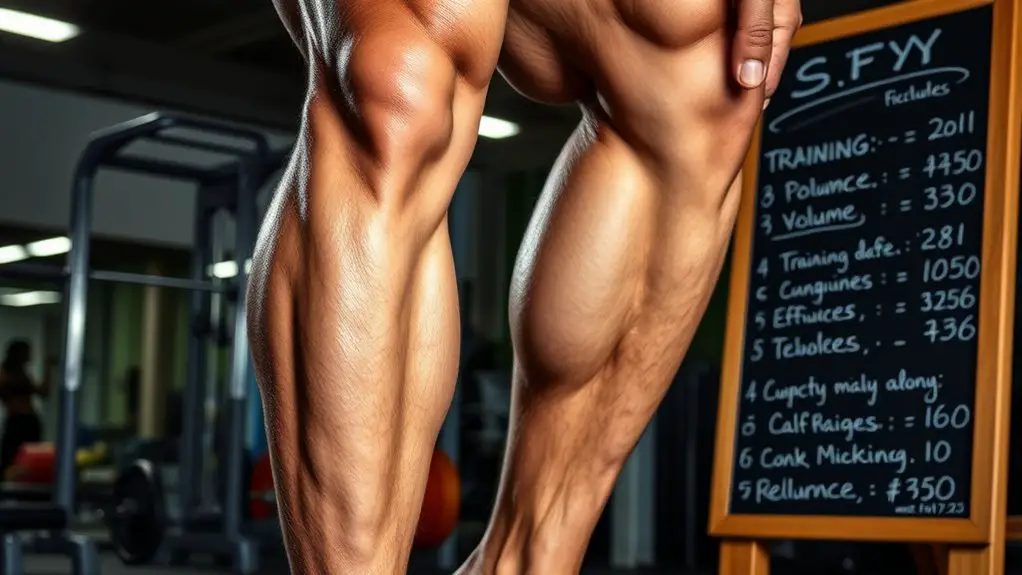
To build bigger calves, understanding the right training frequency and volume is essential. You’ll want to find that balance between pushing your limits and allowing adequate recovery for growth. Let’s explore how often you should train and how much volume is ideal for maximizing your results.
Optimal Training Frequency
Finding the right training frequency for your calves is essential if you want to see significant growth. Aim for 2 to 3 calf workouts per week, allowing adequate recovery between sessions. This frequency helps stimulate muscle growth while minimizing the risk of overtraining. You can incorporate calf exercises into your existing training splits, like leg days or upper/lower body routines. Be mindful of your body’s signals; if you feel excessive soreness or fatigue, consider adjusting your frequency. Additionally, guarantee your calf workouts include a mix of standing and seated exercises for balanced development. Remember, consistency is key, so stick to your routine while giving your muscles time to recover. Safe training leads to the best results!
Volume for Growth
When it comes to building bigger calves, volume plays a crucial role in stimulating muscle growth. To effectively implement calf hypertrophy strategies, focus on increasing both the number of sets and reps in your workouts. Ideally, aim for 3 to 5 sets of 8 to 15 reps, depending on your current fitness level. Incorporating training intensity techniques, like drop sets or supersets, can further enhance your results while ensuring you stay safe. Remember, it is important to listen to your body and avoid overtraining, which can lead to injuries. You might also want to take into account varying your exercises, including standing and seated calf raises, to target different muscle fibers. Consistency and smart volume management will help you achieve the calves you desire.
Recovery Importance
While many people focus solely on training volume to build bigger calves, recovery is equally essential for muscle growth and overall performance. Your muscles need adequate rest recovery to repair and strengthen after intense workouts. Overtraining can lead to fatigue and even injury, so listen to your body. Aim for at least 48 hours of recovery before targeting your calves again, allowing time for muscle repair. Incorporating lighter training sessions or alternative exercises can also help maintain muscle activity while giving your calves a break. Remember, it’s not just about how much you lift but how well you recuperate. Prioritizing recovery guarantees you maximize your efforts in the gym, leading to bigger, stronger calves over time.
Nutrition for Calf Growth
To maximize calf growth, you can’t overlook the importance of proper nutrition. Achieving a balanced diet is fundamental for fueling your workouts and promoting recovery. Here are three key factors to take into account:
Proper nutrition is essential for calf growth, supporting workouts and recovery through a balanced diet.
- Calorie Surplus: Make sure you’re consuming more calories than you burn. This supports muscle growth.
- Protein Sources: Incorporate lean meats, dairy, and plant-based proteins for ideal muscle repair. Aim for a macro balance that includes fats and carbohydrates for energy.
- Hydration Strategies: Staying hydrated is essential. Water helps transport nutrients and aids in recovery.
Don’t forget about nutrient timing; consuming protein and carbohydrates around your workouts can enhance performance. Meal planning is also critical to make sure you’re meeting your fiber intake and overall nutritional needs. Finally, explore supplement options to fill any gaps in your diet, but consult a professional to guarantee safety. By focusing on these aspects, you’ll create an environment conducive to calf growth.
Stretching and Mobility for Calves
Incorporating stretching and mobility exercises into your routine can greatly enhance calf development and overall performance. Start with dynamic stretching before your workouts to warm up your calves and promote muscle activation. Think leg swings or high knees to get the blood flowing. Foam rolling is another effective technique to release tension and improve calf flexibility. Spend a few minutes targeting the calves, focusing on tight spots to aid recovery.
Don’t overlook ankle mobility; improving this can directly affect your calf workouts. Incorporate exercises like ankle circles or wall stretches to enhance your range improvement. As your calves become more flexible and mobile, you’ll notice better performance during lifts and reduced risk of injury. Always listen to your body and avoid overstretching; gradual progress is key. With consistent effort, you’ll build stronger, bigger calves while ensuring safety in your training routine.
Incorporating Calves Into Your Routine
Building bigger calves requires a strategic approach, as neglecting them in your routine can lead to imbalances and hinder overall leg development. To effectively incorporate calves into your gym routine, consider the following:
- Calf Raises: Integrate both standing and seated calf raises into your workouts. This targets different muscle fibers for balanced growth.
- Workout Variations: Vary your calf exercises by including single-leg raises or using resistance bands. This adds diversity and helps prevent plateaus.
- Training Intensity: Focus on progressive overload. Gradually increase weights or reps to enhance training intensity, ensuring continuous muscle growth while avoiding injury.
Remember to give your calves the attention they deserve. Incorporating these elements not only enhances your overall leg aesthetics but also promotes balanced strength, which is essential for safe and effective training.
Tracking Progress and Making Adjustments
To build bigger calves, it’s essential to monitor your workout frequency and the weights you’re using. Adjusting your reps and resistance can make a big difference in your muscle growth. Keeping track of these factors will help you stay on the right path to achieving your goals.
Monitor Workout Frequency
Regularly monitoring your workout frequency is essential for achieving bigger calves. By keeping track, you can guarantee adequate muscle recovery and prevent overtraining. Here are three tips to help you maintain an effective calf workout schedule:
- Frequency: Aim for 2-3 calf workouts per week, allowing at least 48 hours of recovery between sessions.
- Progression: Track your workout frequency and adjust as needed. If you’re not seeing improvement, consider adding an extra session or varying your routine.
- Listen to Your Body: Pay attention to signs of fatigue or discomfort. If you’re feeling overly sore, it may be time to reduce your frequency for better muscle recovery.
Adjust Weight and Reps
As you progress in your calf training, adjusting weight and reps becomes essential for continued growth. It’s vital to listen to your body and guarantee you’re using a weight that challenges you but doesn’t compromise your form. For calf raises, start with a manageable weight, focusing on performing each rep slowly and controlled. Once you can comfortably complete your target reps, it’s time to reflect on weight progression. Aim to increase the weight by small increments, allowing your muscles to adapt safely. Don’t rush the process; gradual changes lead to sustainable gains. Tracking your progress helps you identify when to increase reps or weight, assuring your calves stay challenged and grow stronger without risking injury.
Frequently Asked Questions
How Long Does It Take to See Results in Calf Size?
It usually takes several weeks to see noticeable results in calf size, depending on your calf training frequency and consistency. If you’re training your calves two to three times a week, you might start seeing changes in about 4 to 6 weeks. Remember, muscle recovery time is essential, so give your calves enough rest to grow. Stay patient and committed, and you’ll likely achieve the results you’re aiming for while staying safe.
Can Genetics Affect My Calf Muscle Growth?
Yes, your calf genetics can play a significant role in your muscle response to training. Some people naturally have a greater potential for muscle growth in their calves due to inherited traits. However, that doesn’t mean you can’t improve your calf size. With consistent effort and the right exercises, you can still achieve noticeable gains. Remember to focus on form and safety to avoid injury while working towards your goals!
Is It Necessary to Use Weights for Calf Training?
You might think weights are necessary for effective calf training, but that’s not true! Bodyweight exercises can be just as beneficial. Incorporating calf variations like single-leg raises or elevated heel stretches can help you develop strength and size without the added strain of weights. As long as you focus on proper form and controlled movements, you can safely build your calves while minimizing the risk of injury. So, give those bodyweight exercises a try!
Should I Train Calves on Leg Day or Separately?
When deciding whether to train calves on leg day or separately, consider your calf training frequency and overall workout split. If you’re focusing on safety and recovery, integrating calves into leg day might be beneficial, allowing for more balanced muscle engagement. However, if you want to prioritize calf growth, training them separately can guarantee they get the attention they need without fatigue from other leg exercises. Listen to your body and adjust accordingly.
What Footwear Is Best for Calf Exercises?
When it comes to calf exercises, the right footwear can make a difference. You might want to contemplate cross training shoes as they provide stability and support during various movements. If you prefer a more natural feel, minimalist footwear can also be a good choice, allowing your feet to engage more fully. Just remember, whichever you choose, make sure they fit well and offer enough grip to keep you safe while working those calves.
